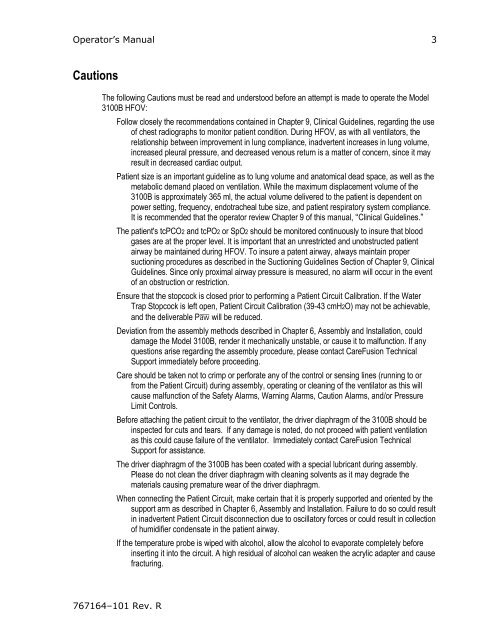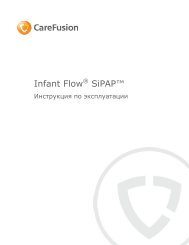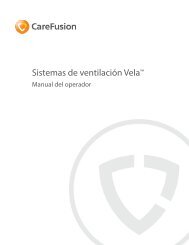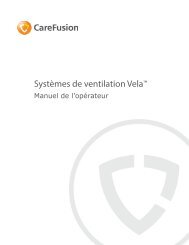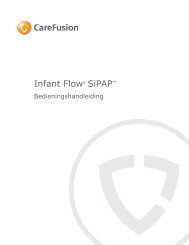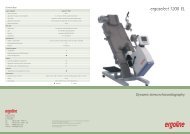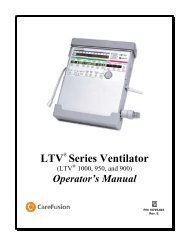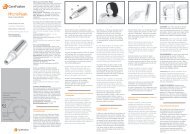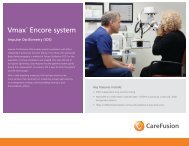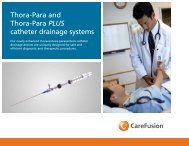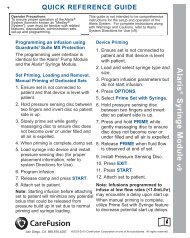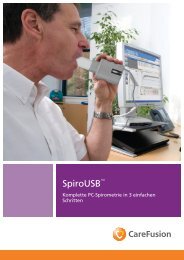3100B HFOV Operator Manual - CareFusion
3100B HFOV Operator Manual - CareFusion
3100B HFOV Operator Manual - CareFusion
Create successful ePaper yourself
Turn your PDF publications into a flip-book with our unique Google optimized e-Paper software.
<strong>Operator</strong>’s <strong>Manual</strong> 3<br />
Cautions<br />
The following Cautions must be read and understood before an attempt is made to operate the Model<br />
<strong>3100B</strong> <strong>HFOV</strong>:<br />
Follow closely the recommendations contained in Chapter 9, Clinical Guidelines, regarding the use<br />
of chest radiographs to monitor patient condition. During <strong>HFOV</strong>, as with all ventilators, the<br />
relationship between improvement in lung compliance, inadvertent increases in lung volume,<br />
increased pleural pressure, and decreased venous return is a matter of concern, since it may<br />
result in decreased cardiac output.<br />
Patient size is an important guideline as to lung volume and anatomical dead space, as well as the<br />
metabolic demand placed on ventilation. While the maximum displacement volume of the<br />
<strong>3100B</strong> is approximately 365 ml, the actual volume delivered to the patient is dependent on<br />
power setting, frequency, endotracheal tube size, and patient respiratory system compliance.<br />
It is recommended that the operator review Chapter 9 of this manual, “Clinical Guidelines.”<br />
The patient's tcPCO2 and tcPO2 or SpO2 should be monitored continuously to insure that blood<br />
gases are at the proper level. It is important that an unrestricted and unobstructed patient<br />
airway be maintained during <strong>HFOV</strong>. To insure a patent airway, always maintain proper<br />
suctioning procedures as described in the Suctioning Guidelines Section of Chapter 9, Clinical<br />
Guidelines. Since only proximal airway pressure is measured, no alarm will occur in the event<br />
of an obstruction or restriction.<br />
Ensure that the stopcock is closed prior to performing a Patient Circuit Calibration. If the Water<br />
Trap Stopcock is left open, Patient Circuit Calibration (39-43 cmH2O) may not be achievable,<br />
and the deliverable Pa will be reduced.<br />
Deviation from the assembly methods described in Chapter 6, Assembly and Installation, could<br />
damage the Model <strong>3100B</strong>, render it mechanically unstable, or cause it to malfunction. If any<br />
questions arise regarding the assembly procedure, please contact <strong>CareFusion</strong> Technical<br />
Support immediately before proceeding.<br />
Care should be taken not to crimp or perforate any of the control or sensing lines (running to or<br />
from the Patient Circuit) during assembly, operating or cleaning of the ventilator as this will<br />
cause malfunction of the Safety Alarms, Warning Alarms, Caution Alarms, and/or Pressure<br />
Limit Controls.<br />
Before attaching the patient circuit to the ventilator, the driver diaphragm of the <strong>3100B</strong> should be<br />
inspected for cuts and tears. If any damage is noted, do not proceed with patient ventilation<br />
as this could cause failure of the ventilator. Immediately contact <strong>CareFusion</strong> Technical<br />
Support for assistance.<br />
The driver diaphragm of the <strong>3100B</strong> has been coated with a special lubricant during assembly.<br />
Please do not clean the driver diaphragm with cleaning solvents as it may degrade the<br />
materials causing premature wear of the driver diaphragm.<br />
When connecting the Patient Circuit, make certain that it is properly supported and oriented by the<br />
support arm as described in Chapter 6, Assembly and Installation. Failure to do so could result<br />
in inadvertent Patient Circuit disconnection due to oscillatory forces or could result in collection<br />
of humidifier condensate in the patient airway.<br />
If the temperature probe is wiped with alcohol, allow the alcohol to evaporate completely before<br />
inserting it into the circuit. A high residual of alcohol can weaken the acrylic adapter and cause<br />
fracturing.<br />
767164–101 Rev. R


